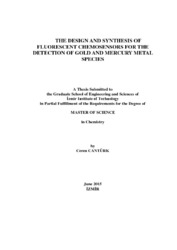Please use this identifier to cite or link to this item:
https://hdl.handle.net/11147/4325| Title: | The Design and Synthesis of Fluorescent Chemosensors for the Detection of Gold and Mercury Metal Species | Other Titles: | Altın ve Civa Metal Bileşiklerinin Tayin Edilmesi için Floresan Özellikte Kemosensörlerin Tasarlanması ve Sentezlenmesi | Authors: | Cantürk, Ceren | Advisors: | Emrullahoğlu, Mustafa | Keywords: | Fluorescence Chemosensors |
Publisher: | Izmir Institute of Technology | Source: | Cantürk, C. (2015). The design and synthesis of fluorescent chemosensors for the detection of gold and mercury metal species. Unpublished master's thesis, İzmir Institute of Technology, İzmir, Turkey | Abstract: | This study describes the design, synthesis and spectral behaviour of a fluorescent molecular sensor which is able to recognize Hg2+ and Au3+ ions via different emission modes.
Determination of identity and amount of heavy metal ions has crucial importance for scientific researches. Detection of trace metal ions can be achieved by classical spectroscopic methods such as atomic absorption and atomic emission spectroscopy and inductively-coupled plasma spectrometry. In contrast to these highly expensive and time consuming methods, fluorogenic or chromogenic methods provide an alternative way for the detection of these species. There are many organic molecules that act as signaling unit for fluorogenic sensing strategy such as rhodamine, fluorescein, coumarin and BODIPY derivatives. Among these, BODIPY fluorophore was chosen for this work as a signal reporter due to its unique properties.
In this research, the detection of Hg(II) and Au(III) ions was recognized in two distinct fluorescence changes: one resulting from a reversible Hg2+/sensor complex formation, the other an irreversible Au3+-mediated hydrolysis reaction. The minimum amount of Au(III) and Hg(II) ions detectable in aqueous solution was determined to be 128 nM and 160 nM, respectively. The capacity of the developed probe for imaging was studied in living cells. The investigation showed that the probe can be used efficiently for in vitro imaging of Au3+ and Hg2+ species. Bu çalışmada Au(III) ve Hg(II) metal iyonlarının tayin edilebilmesi için floresan özellik gösteren BODIPY yapısında bir kemosensör tasarlanıp sentezlenmiş ve spektral özellikleri incelenmiştir. Ağır ve geçiş metal iyonlarının tespiti için kemosensör tasarımı oldukça önemlidir. Çünkü bu iyonlar biyolojik sistemlerde önemli rol almakta ve buna karşın çevreye son derece toksik etkiler gösterebilmektedir. Bu iyonların tayini için atomik absorpsiyon ve atomik emisyon spektroskopisi, indüktif olarak eşleşmiş plazma spektrometresi gibi spektroskopik yöntemler kullanılabilir, ancak bu yöntemler karmaşık örnek hazırlama aşamaları ve sofistike cihazlar gerektirmektedir. Bu son derece pahalı ve zaman alıcı yöntemlerin yerine florojenik ve kromojenik yöntemler bu türlerin saptanması için iyi bir alternatif olabilir. Bilinen diğer floroforlara kıyasla sahip olduğu eşsiz özellikleriyle BODIPY floroforu metal iyon kemosensörü yapımı için oldukça iyi bir örnektir. Bu tez çalışmasında Au3+ ve Hg2+ metal iyonlarının tayini iki farklı floresan değişimiyle gözlemlenmiştir. Hg(II) iyonlarının tayini tersinir Hg-sensör kompleks oluşumuna dayanırken, Au(III) iyonları tayini tek yönlü hidroliz reaksiyonu üzerinden gerçekleşmiştir. Yapılan ölçümler sonucunda sulu çözelti içerisinde tayin edilebilen en düşük Au3+ ve Hg2+ iyon miktarı sırasıyla 128 nM ve 160 nM olarak belirlenmiştir. Aynı zamanda, altın ve civa iyonlarına duyarlı olarak tasarlanan bu sensörün hücre içerisindeki aktivitesi de başarılı bir şekilde gösterilmiştir. |
Description: | Thesis (Master)--İzmir Institute of Technology, Chemistry, İzmir, 2015 Includes bibliographical references (leaves: 47-51) Text in English; Abstract: Turkish and English ix, 59 leaves |
URI: | http://hdl.handle.net/11147/4325 |
| Appears in Collections: | Master Degree / Yüksek Lisans Tezleri |
Files in This Item:
| File | Description | Size | Format | |
|---|---|---|---|---|
| T001341.pdf | MasterThesis | 2.71 MB | Adobe PDF |  View/Open |
CORE Recommender
Page view(s)
298
checked on Apr 21, 2025
Download(s)
260
checked on Apr 21, 2025
Google ScholarTM
Check
Items in GCRIS Repository are protected by copyright, with all rights reserved, unless otherwise indicated.